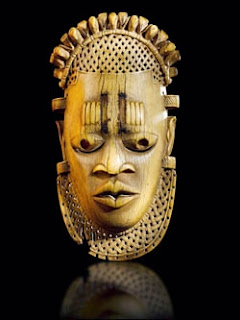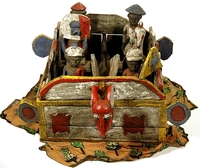A rare £4.5 million West African ivory mask, believed to have been looted by the British during a 19th century invasion of Benin (in present-day Nigeria), was withdrawn from a Sotheby's sale slated for February. The withdrawal was in response to online protests regarding claims of cultural patrimony and demands for repatriation.
The mask, one of the last great masterpieces of Benin sculpture remaining in private hands, is believed to have been worn by the "Oba" or king of Benin on ceremonial occasions. It depicts the head of the queen mother of the Edo peoples and has a refined and untouched surface, which has been well treated with palm oil.
The protests were organized and led by the Nigeria Liberty Forum (NLF), an activist group of Nigerians and friends of Nigeria. The group describes themselves as "UK-based Nigerian pro-democracy group." The protests began last week on social networking sites and an online petition circulated by the group. Local government officials in Nigeria have publicly condemned the sale and criticized the current owners.
"It is a shame that in this time and age individuals continue to plunder and abuse the culture and heritage of a defenseless people just because they can," NLF's letter to Sotheby's stated. "To this end we request that you withdraw the items from the sale forthwith as the true ownership is far from settled. We would also like to request that you go a step further and advise your clients to return these items back to the Nigerian people where they rightfully belong."
The mask was one of several items to be sold at Sotheby's in London by the descendants of Lt. Col. Sir Henry Gallwey, a vice consul of a British protectorate in Nigeria who took part in the 1897 invasion of Benin when the British deposed the king and burned and looted the city. They auctioned off much of the objects to pay for the offensive. Several pieces, including a mask similar to the one withdrawn from Sotheby's auction, were ultimately placed in the British Museum.
Sotheby's official statement:
“The Benin Ivory Pendant Mask and other items consigned by the descendants of Lionel Galway which Sotheby’s had announced for auction in February 2011 have been withdrawn from sale at the request of the consignors.”

























